Rigs as reefs: An opportunity for creative, sustainable resource management
There are over 6,000 offshore oil and gas platforms found in almost every ocean on the planet.1 Many of these structures are aging infrastructure, leftover designs from an era when developing and extracting the world’s offshore petroleum reserves was paramount, while little thought was given to their eventual removal, Fig. 1. However, as some offshore oil and gas reservoirs have depleted, and the global economy has diversified toward more renewables (i.e. offshore wind, wave and solar energy), the removal of many of these structures has become inevitable. So, the technical, economic and environmental implications associated with their decommissioning must now be addressed.
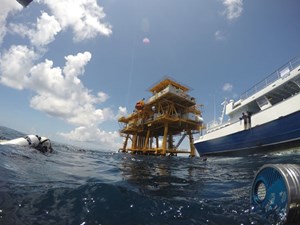
MARINE LIFE AMONG OFFSHORE PLATFORMS
Completely removing an offshore oil and gas platform can be costly and environmentally taxing, especially when you consider the marine ecosystems that can be found colonizing these structures. For beneath most oil and gas platforms, a unique and abundant marine community thrives, with an average structure providing a home for thousands of fishes and between 2 and 3 acres of habitat, Fig. 2.
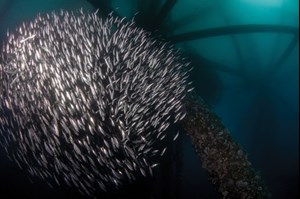
In fact, recent publications have indicated that the oil platforms found off the coast of California, some of the most well-studied platforms in the world, are among the most productive ecosystems on the planet. When a platform is first installed, it quickly attracts a variety of marine species, and eventually, that attraction shifts into production, each platform forming small ecosystems that in some cases, may evolve into habitats that are more productive than mangrove forests, rocky reefs, and even estuaries.2
Completely removing or decommissioning an offshore oil and gas platform presents several unexpected ecological complexities, many of which pertain to the age-old question of production versus attraction. Are these platforms merely providing temporary shelter for passing marine life? Or are they actual producing additional biomass? If they are producing biomass, as many studies indicate, then their value ecologically becomes increasingly important.
In this article, our marine conservation biologists and energy consultants at Blue Latitudes shed light on how re-imaging “Rigs as Reefs” is a proven circular economy approach, which can maintain the value of ecosystem services and redefine industrial growth in the Blue Economy.
DECOMMISSIONING CONSIDERATIONS
Decommissioning is the last phase of any offshore oil and gas project. When an oil reserve and its associated wells reach the end of their economic lives, the process of decommissioning begins. Traditional decommissioning involves the completely removing platform infrastructure from the seafloor, resulting in loss of habitat and destruction of the marine ecosystems that have colonized the structure over its operational lifespan.
Through this process, all the wells must be plugged and abandoned safely. The topside facilities (Fig. 3), platform jacket and any drilling infrastructure must be disconnected and removed from the seafloor and towed to shore for disposal or recycling. Finally, the sea floor is returned to its original, unobstructed condition.
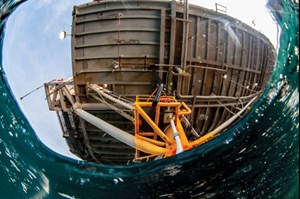
The Rigs to Reefs alternative. Rigs to Reefs (RtR), however, provides an alternative to complete platform removal, enabling oil companies to save on decommissioning costs by modifying their platform structures, so that they can continue to support marine life as artificial reefs. Through this decommissioning process, the oil well is sealed and capped, all drilling infrastructure is removed, and the upper 85 feet of the platform structure are towed to another location, toppled in place, or removed, Fig. 4.4
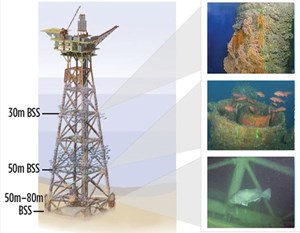
The operating company then donates the remaining underwater infrastructure, or “jacket,” to relevant local and/or state natural resource managers to be maintained as artificial reefs. While RtR conversions can save oil companies millions of dollars in decommissioning costs, not all platforms are suitable as reefing candidates. Considerations for the platform’s location, water depth, stability, structural complexity, and age, among other features (i.e. implications to stakeholders), must be assessed on a case-by-case basis to holistically determine the reefing viability of any platform candidate, Fig. 5. In the Gulf of Mexico, the decommissioning of offshore oil and gas platforms currently exceeds installation rates, and while RtR is a viable option for some platforms, complete removal continues to be the default decommissioning option in the United States.5
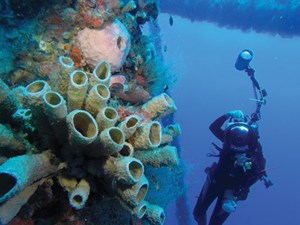
Economic realities. The ecological benefits are not the only reasons to complete an RtR conversion. There are also significant financial gains that can benefit both oil company stakeholders and state and local stakeholders. In the Gulf of Mexico, costs can run as high as $200 million to completely remove a large deepwater platform, with daily derrick barge costs running as high as $700,000/day to transport the structure to its final disposal site.6
In California, home to some of the oldest and deepest platforms in the world, estimated removal costs range from $272 million to $459 million.7 Decommissioning in place through the RtR program would result in decommissioning costs being cut in half, with average cost- savings amounting to nearly $22 million per platform decommissioned.8
In the United States, established RtR programs mandate that these cost-savings be shared with the state to fund the RtR program, marine education, and conservation. For example, in California, if 23 of California’s 27 offshore oil and gas platforms were to be reefed, the state of California would receive upwards of $650 million to $850 million of the total $1 billion in saved costs.9 These funds incentivize the state to accept liability for the structure and ensure that both the oil company shareholders and the state benefit financially.
RTR OUTSIDE THE U.S.
Worldwide, RtR programs remain uncommon. The reasons for this vary from state to state, and from country to country, but they include challenges, such as a lack of policy to facilitate RtR program implementation; public disapproval of the program; stakeholder conflicts; and a lack of understanding regarding the ecosystem benefits of implementing such a program.
However, these are the challenges that our women-owned marine environmental consulting firm, Blue Latitudes LLC, has been tackling head-on. Blue Latitudes understands the often-complex environmental issues that face the offshore energy industry and has developed relationships with both federal and state regulatory agencies that are based on a shared goal to manage offshore resources in a way that is both environmentally sustainable and fiscally responsible. As environmental consultants, we work to unite science, policy and communications to solve the ecological challenges associated with re-purposing offshore oil and gas platforms as artificial reefs through the RtR program, Fig. 6.
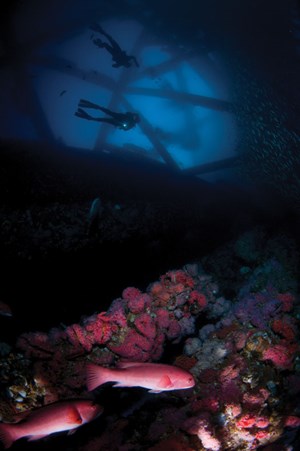
Key examples of our work include re-purposing offshore infrastructure, such as oil and gas platforms, as artificial reefs, utilizing remotely operated vehicles to conduct ecological surveys, and mapping our oceans with Global Fishing Watch. The latter visually presents solutions that lessen the frequency of negative interactions among commercial fisheries stakeholders. We combine our industry expertise with research-based insights and technical tools to assess offshore infrastructure on a case-by-case basis, to determine the best environmental, economic, and socially responsible outcomes available for our clients.
In our daily lives, we use plastics, we drive our cars to work, and turn lights on and off in our homes. We contribute to the global demand for offshore oil and gas. This demand has led to the development of offshore oil and gas platforms in oceans around the world. At some point, these platforms will reach the end of their economically productive lives, and this is when we dive in. We are marine scientists, on a mission to re-purpose offshore platforms as artificial reefs, Fig. 7.
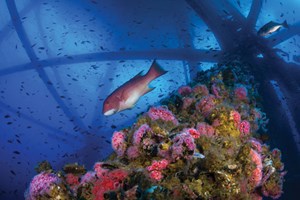
However, re-using existing materials and re-purposing them for environmental benefit is not just relegated to offshore platforms. We can apply this concept to a variety of industries, from offshore wind to aquaculture. The RtR program has proven to be a replicable, scalable solution that can catalyze sustainable ocean resource development. With more than 500 structures converted during the last 30 years in the Gulf of Mexico, RtR is a proven circular economy approach that helps maintain the value of ecosystem services and redefine industrial growth while providing a platform for new industries, such as offshore wind, marine aquaculture, and ecotourism.10
Our vision at Blue Latitudes is to find silver linings in our oceans at the intersection of industry and the environment. We are deeply invested in the concept of re-purposing offshore energy infrastructure for the benefit of the environment. Repurposing an object into something sustainable and environmentally friendly is inherently fresh, and, we believe, timely. Our project work is diverse, but our research is fundamentally based in creative thinking. We are committed to changing the way society thinks about ocean conservation and the future sustainability of our ocean resources.
REFERENCES
- University of California at Santa Barbara, 2019. Transitioning old oil rigs into permanent reefs. Science Daily, Jan. 31, 2019. Available at: https://www.sciencedaily.com/releases/2019/01/190131113909.htm
- Claisse, J. T., D. J. Pondella, M. Love, L. A. Zahn, C. M. Williams, J. P. Williams, and A. S. Bull, “Oil platforms off California are among the most productive marine fish habitats globally,” Proc Natl Acad Sci USA 111(43):15462–15467, 2014. Available at: https://www.pnas.org/content/111/43/15462
- Ibid.
- Gonzales, C., E. Hazelwood, and A. Sparks, “Overview of Rigs to Reefs: Legislation in California and the Gulf of Mexico. Louisiana State University Journal of Energy Law and Resources, 2 (8), 2020. Available at: https://digitalcommons.law.lsu.edu/jelr/vol8/iss2/5/
- Bull, A. S., and M. S. Love, “Worldwide oil and gas platform decommissioning: A review of practices and reefing options,” Ocean & Coastal Management, 168, 274-306, doi:10.1016/j.ocecoaman.2018.10.024, 2019.
- Harrington, K., “Rigs-to-Reefs program saves time, money and boosts marine life,” ChEnected, 24 June, 2014. Available at: https://www.aiche.org/chenected/2014/06/rigs-reefs-program-saves-time-money-and-boosts-marine-life
- BSEE, Decommissioning Cost Update for Pacific OCS Region Facilities, Volume 1, Report No. 735, 143 p., 2016. https://www.bsee.gov/sites/bsee.gov/files/tap-technical-assessment-program//decommissioning-cost-update-for-pacific-ocs-region-facilities-volume-1-rev5.pdf
- Twomey, B. G., “Study assesses Asia-Pacific offshore decommissioning costs,” Oil and Gas Journal, May 15, 2010.
- Bressler, A. and B. Bernstein, 2015.
- Satterlee, K., S. Watson and E. Danenberger, “New opportunities for offshore oil and gas platforms–efficient, effective, and adaptable facilities for offshore research, monitoring, and technology testing,” OCEANS 2018 MTS/IEEE Charleston, 2018, pp. 1-5, doi: 10.1109/OCEANS.2018.8604935.
- Advancing offshore decarbonization through electrification of FPSOs (March 2024)
- Subsea technology- Corrosion monitoring: From failure to success (February 2024)
- Driving MPD adoption with performance-enhancing technologies (January 2024)
- Digital transformation: A breakthrough year for digitalization in the offshore sector (January 2024)
- Offshore technology: Platform design: Is the next generation of offshore platforms changing offshore energy? (December 2023)
- 2024: A policy crossroads for American offshore energy (December 2023)


